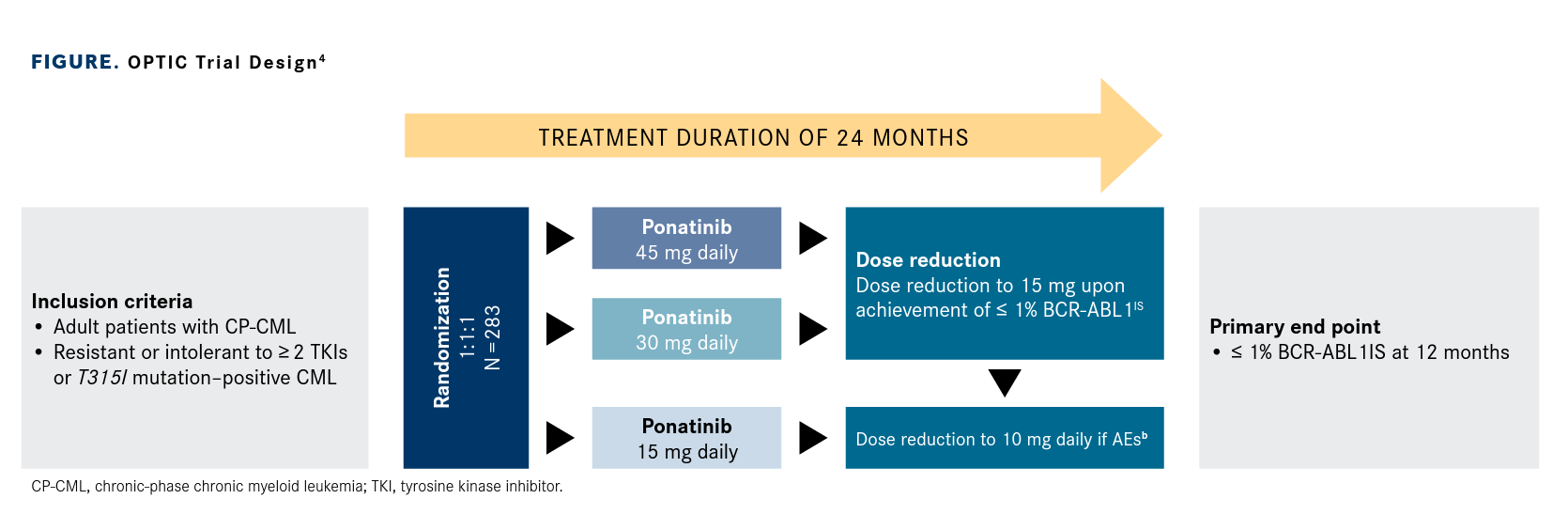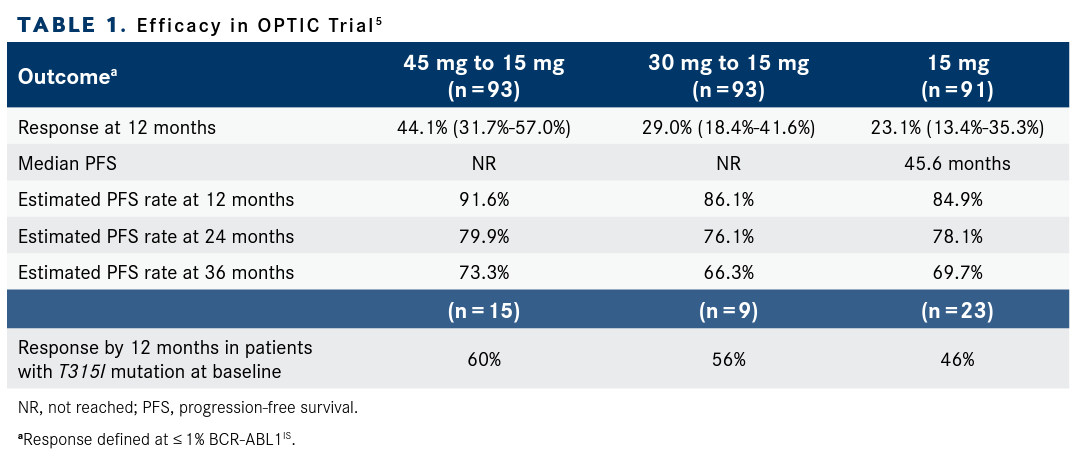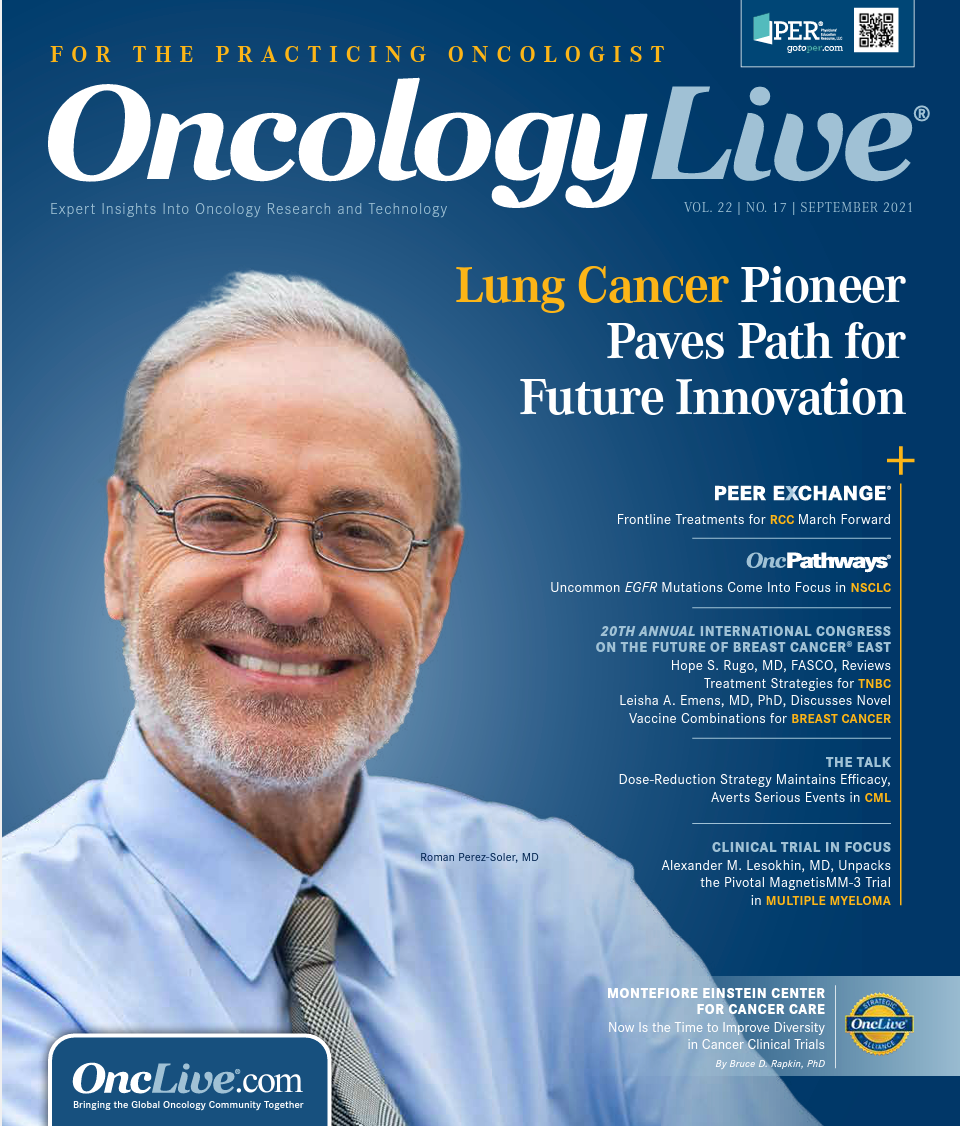Publication
Article
Dose-Reduction Strategy Maintains Efficacy, Averts Serious Events in CML
Author(s):
Despite early induced efficacy first- and second-generation tyrosine kinase inhibitors have limited efficacy for patients with chronic myeloid leukemia.
Jorge E. Cortes, MD

Despite early induced efficacy first- and second-generation tyrosine kinase inhibitors (TKIs) have limited efficacy for patients with chronic myeloid leukemia (CML). Disease resistance occurs in approximately 40% of patients who receive the standard treatment with imatinib (Gleevec). In the second-line setting, patients who initially respond to treatment with a second-generation TKI, approximately 26% lose response within 2 years and up to 50% experience no response at all.1
Investigators have determined that the development of point mutations in the BCR-ABL pathway is a contributing factor to resistance and is associated with poor prognosis.1,2 A third-generation TKI, ponatinib (Iclusig), has demonstrated activity against T315I, a mutation of BCR-ABL that is present in approximately 20% of patients with CML whose disease develops resistance to other TKIs. Deep and durable responses were observed with the agent in the phase 2 PACE trial (NCT01207440), the data from which supported the 2012 FDA approval.2
However, safety data demonstrating high incidence of arterial occlusion events prompted the agency to include a boxed warning and recommended dose-reduction guidelines on the prescribing information.3
These safety concerns prompted investigators to revisit the dosing recommendations for ponatinib across histologic subtypes. Investigators of the OPTIC trial (NCT02467270) set out to evaluate the optimal risk-benefit profile of lower doses of ponatinib (FIGURE).4
FIGURE. OPTIC Trial Design

A primary analysis of OPTIC, presented at the 2021 American Society of Clinical Oncology (ASCO) Annual Meeting, demonstrated benefit in patients with resistant CML in the 3 dosing regimens evaluated.5 The largest benefit was observed in patients who were enrolled in the 45-mg to 15-mg dose-reduction cohort, meeting the primary end point of the study (TABLE 15). For patients enrolled in the 30- and 45-mg cohorts, 73 patients had a dose reduction to 15 mg and 55 (75%) maintained a response to treatment. In the 45-mg cohort specifically, 45 patients (73.3%) had a dose reduction to 15 mg after achieving BCR-ABLIS transcript level of less than 1%.
TABLE 1. Efficacy in OPTIC Trial

Moreover, investigators reported that most patients who had dose re-escalation in the 45-mg (n = 13) and 30-mg (n = 5) cohorts after loss of response regained less than 1% BCR-ABLIS (61.5% and 80%, respectively). The median time to regain response was 3.9 months for those in the 45-mg cohort and 4.2 months for those in the 30-mg cohort.
The incidence of treatment-emergent arterial occlusion events decreased in correlation with dose reductions in the study (TABLE 25). The rates of these events in patients who achieved a response by 12 months were 9.6%, 5.3%, and 3.2% in the 45-, 30-, and 15-mg starting dose cohorts, respectively.
TABLE 2. Risk/Benefit in OPTIC Trial

The analysis demonstrated that in clinical practice, establishing a treatment algorithm that stratifies patients based on comorbidities, mutational status, and response to prior treatment. This method may maximize the efficacy of ponatinib maintenance therapy and avoid increased risk of arterial occlusion events.
Lead investigator Jorge E. Cortes, MD, was joined by a panel of experts in hematologic malignancies including Elias Jabbour, MD; B. Douglas Smith, MD; and Robert Foà, MD, for a discussion of the OPTIC data as part of the OncLive® Leukemia Talk program.
Cortes: I’m going to start by introducing an abstract that I presented at ASCO—the results of the OPTIC trial. We all know that ponatinib has been a very effective drug, and when it came it was very exciting. It inhibited T315I with high rates of response in patients who had received multiple prior therapies. Shortly after that excitement, the recognition of arterial occlusive events arrived.
Different numbers have been thrown around, but incidence was approximately 20% to 30% and the bottom line is that this has limited the use of ponatinib. Something that many investigators first started doing was using lower doses or starting at lower doses of ponatinib to try to minimize the risk.
OPTIC [investigators examined] prospective data for the use of lower starting doses to see whether that would minimize the safety concerns but maintain the efficacy, because you want to keep the efficacy that we like from ponatinib. Patients received either 45-mg, 30-mg, or 15-mg starting dose. One important thing of the trial design here is that patients who responded—response was defined as 1% or less of the transcript levels—were mandated to reduce to 15 mg daily. What these study data showed was that the 45-mg dose was by far the most effective. The response rate was almost 45%, whereas it was 29% at the 30-mg dose and even lower with the 15-mg dose [Table 1].
In a subset analysis, patients with the worst [prognostic] features had the biggest difference—patients with T315I mutations, patients who had received [1 or] more TKIs, all of that. Clearly, from the efficacy point of view, there was a big difference in favor of the standard dose, the 45-mg daily dose. Most patients maintained response after dose reduction; although approximately a quarter lost the response, many of them regained response after re-escalation of the dose.
In terms of arterial occlusive events, there is a difference. The rate of any arterial occlusive event was approximately 10% with 45 mg and is approximately 5% with 30 mg [Table 2]. There is a price to pay for that higher efficacy. Now, the difference between the efficacy and the safety is much larger in favor of the efficacy, meaning you gain a lot more by using the 45 mg than you lose, but you do lose some [with the] higher rate of arterial occlusive events.
The conclusion here is that 45 mg is the [dose] that provides the best ratio of risk and benefit. This efficacy-driven dose reduction has made it into the label of ponatinib, which remains now with a standard dose of 45 mg daily, and it gives some light to how to use ponatinib.
One important thing is that the overall rate of these arterial occlusive events is lower than we had seen [in the data from the] PACE trial [NCT01207440], and you could argue whether this is [a result of] the efficacy-driven dose reduction or whether there are more stringent eligibility criteria. [You must also ask] whether that is enough for us to consider 45 mg daily.
I will say that, for me, I prefer 45 mg for most of my patients. Perhaps for the highest-risk patients in terms of arterial occlusive events, you may want to consider 30 mg, but you must acknowledge that you give up something in terms of efficacy. Again, I find myself using 45 mg more often than 30 mg, and certainly much more than 15 mg, which I hardly ever use. I don’t know if anybody sees this differently.
Dr Jabbour, how do you see this data, and how do you do it in your practice for patients with CML?
Elias Jabbour, MD

Jabbour: I think dose adjustment is very important, and the fact that once you induce an optimal response reducing the dose of the drug seems to not compromise the efficacy in the majority of patients while optimizing the safety concerns [is important to note].
We know that [from experience with] patients with Ph-positive ALL [Philadelphia chromosome–positive acute lymphoblastic leukemia]—when we started 45 mg, 30 mg, and 15 mg—we did not compromise on efficacy once [there was] an optimal response and it was maintained, we did see a reduction of the vascular events.
When it comes to the OPTIC trial, [there is] something I am struggling to understand. The data showed that the 45-mg dose reduced to 15 mg is better in inducing CCyR [complete cytogenetic response] than the 2 other arms, and this benefit was mainly seen in patients with a T315I mutation, in those who failed multiple TKIs, or compound mutations, which we know this is the worst group. But when it comes to PFS [progression-free survival] and survival there’s no difference, so why is that? Or did you do a subset analysis by T315I mutation for PFS and survival?
Cortes: Well, a couple of things. The PFS curves are starting to open up. When we presented this a year ago there was no difference; by now the 3-year [PFS] probability is 73% vs 66% with 30 mg. Survival [curves are not opening up] yet. I think it is a matter of the follow-up.
Now you mentioned the difference in ALL between the different doses, but of course there we use it in combination with chemotherapy, so that compensates to some extent anything that you may lose. Doug, any thoughts on this?
B. Douglas Smith, MD

Smith: I loved this study, and I loved it because I think that it’s a very interesting model, and this model needs to be applied to other uses of TKIs. For example, there is probably a way to optimize dosing for each of the different TKIs based on response and based on time to that response, so that we could have patients on less drug and have less long-term toxicities.
Even if those toxicities are not as dramatic as we sometimes see with high-dose ponatinib, they’re still important. So, I love this model that you’ve put out there for people to follow. I think we need more data with the other TKIs, but I think that this has really shown some great insight. I really liked it.
Cortes: You bring a very good point. Beyond what it means for the use of ponatinib, [this model] may extend to the use of all other TKIs. I have to say I was one of the most reluctant individuals to change doses for patients who were doing well. Why take chances? Of course, early on, we didn’t know what was going to happen long term; now we feel more comfortable.
Do we really need to keep the patients at the maximum dose all the time, even if they’re doing well and not having any adverse effects? This [model of] response-adjusted dose reduction may be the way to go for all the TKIs, at least the second-generation [agents]. I would have my doubts for imatinib [Gleevec]. There’s probably not as much potency to spare. But for the second-generation or the third-generation TKIs, I don’t see why not.
I’ve been a very strong proponent of the higher doses of imatinib. You could start with higher doses of imatinib, which give you rates that are not dissimilar to second-generation TKIs, and then drop [the dosage] down to the standard dose when you get the response that you want. Professor Foà, I think you wanted to mention something.
Robin Foà, MD

Foà: We must keep in mind [that] here we’re talking about CML, which is obviously a disease which we can manage with any TKI, more or less. We’ve had worries with the adverse effects of ponatinib, and I think it’s extremely important particularly for the frail patients or patients with comorbidities. The key point is that now we’re moving toward offering less or no chemotherapy, so we don’t have the effect of chemotherapy stopping it. [Treatment for these patients is] going to be largely a TKI alone, and then maybe chemotherapy after or maybe not at all.
I think that is a key point as a bridge between CML and ALL. The end point is very different. We can always rescue patients with CML in the second line. Ph-positive ALL is very different, and we must obtain MRD [minimal residual disease] negativity as much as we can with the first-line treatment, so we can’t go wrong. I think that’s a key point that we must address in ALL.
References
- Cortes JE, Kim DW, Pinilla-Ibarz J, et al; PACE Investigators. A phase 2 trial of ponatinib in Philadelphia chromosome-positive leukemias. N Engl J Med. 2013;369(19):1783-1796. doi:10.1056/NEJMoa1306494
- Castagnetti F, Pane F, Rosti G, Saglio G, Breccia M. Dosing strategies for improving the risk-benefit profile of ponatinib in patients with chronic myeloid leukemia in chronic phase. Front Oncol. 2021;11:642005. doi:10.3389/fonc.2021.642005
- Iclusig. Prescribing information. Takeda Pharmaceutical Company Ltd; 2020. Accessed August 13, 2021. https://www.accessdata.fda.gov/drugsatfda_docs/label/2020/203469s034lbl.pdf
- Ponatinib in participants with resistant chronic phase chronic myeloid leukemia (CP-CML) to characterize the efficacy and safety of a range of doses (OPTIC). Clinical Trials.gov. Updated June 14, 2021. Accessed August 13, 2021. https://clinicaltrials.gov/ct2/show/NCT02467270
- Cortes JE, Apperley J, Lomaia E, et al. OPTIC primary analysis: a dose-optimization study of 3 starting doses of ponatinib (PON). J Clin Oncol. 2021;39(suppl 15):7000. doi:10.1200/JCO.2021.39.15_suppl.7000










